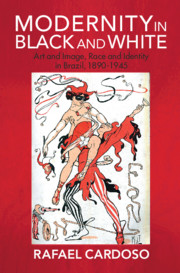Book contents
- Modernity in Black and White
- Afro-Latin America
- Modernity in Black and White
- Copyright page
- Dedication
- Epigraph
- Contents
- Figures
- Acknowledgements
- Notes on Usage of Brazilian Portuguese
- Introduction
- 1 Heart of Darkness in the Bosom of the Modern Metropolis
- 2 A Pagan Festival for the Up to Date
- 3 The Printing of Modern Life
- 4 The Cosmopolitan Savage
- 5 The Face of the Land
- Epilogue
- Index
1 - Heart of Darkness in the Bosom of the Modern Metropolis
Favelas, Race and Barbarity
Published online by Cambridge University Press: 06 April 2021
- Modernity in Black and White
- Afro-Latin America
- Modernity in Black and White
- Copyright page
- Dedication
- Epigraph
- Contents
- Figures
- Acknowledgements
- Notes on Usage of Brazilian Portuguese
- Introduction
- 1 Heart of Darkness in the Bosom of the Modern Metropolis
- 2 A Pagan Festival for the Up to Date
- 3 The Printing of Modern Life
- 4 The Cosmopolitan Savage
- 5 The Face of the Land
- Epilogue
- Index
Summary
The abolition of slavery contributed to a population explosion in Rio de Janeiro over the 1890s and early 1900s which, combined with a severe economic crisis, resulted in a drastic shortage of housing. The urban poor, left to fend for themselves, began to build informal settlements on the city’s empty hillsides. The best known among them was called Morro da Favela, a toponym that mushroomed into a typology, by the 1920s, as more and more communities sprang up based on the favela model. The chapter examines the early representation of favelas in paintings, photographs, illustrations and cartoons, piecing together how the visual record of these communities morphed into convention and stereotype. Favelas quickly came to be pitted as the backdrop of archaism and backwardness against which ideas of modernity were counterposed. They were routinely linked to notions of blackness, Africanness and the wild frontier of Brazil’s hinterland (sertão). However, they also developed a distinct identity as objects of artistic interest and sites of cultural resistance. Attempts by municipal government to raze them eventually met with strong opposition not only from dwellers themselves but also from artists and intellectuals. The visit of futurist leader F.T. Marinetti to Morro da Favela, in 1926, is discussed for its symbolic import.
Keywords
- Type
- Chapter
- Information
- Modernity in Black and WhiteArt and Image, Race and Identity in Brazil, 1890–1945, pp. 26 - 71Publisher: Cambridge University PressPrint publication year: 2021

